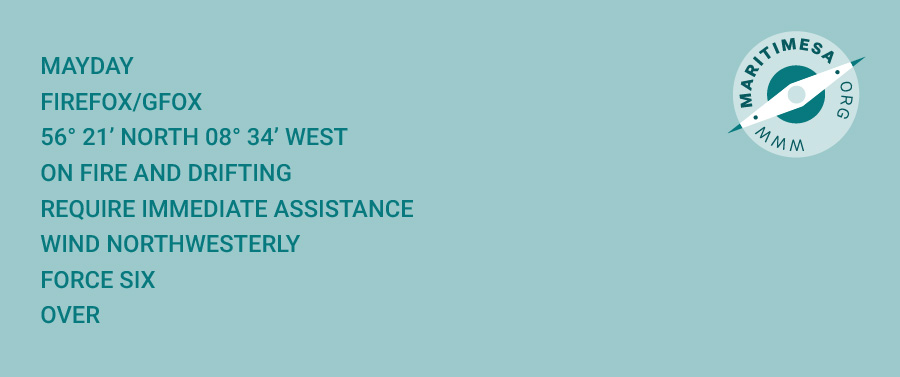A distress call and message is sent when a vessel is in grave and imminent danger. They are only sent on the authority of the master or person responsible for the vessel. A distress call has priority over all other transmissions. All stations receiving a distress call and message must immediately cease any transmissions that may interfere with distress traffic and listen on the frequency used for the call. The call shall not be addressed to a particular station and acknowledgement of receipt shall not be given before the distress message that follows it is sent.
Distress call. The distress call must be made in the following form:
- MAYDAY spoken three times.
- The words “THIS IS” or “DELTA ECHO” (DE).
- The call sign or other identification of the mobile station spoken three times, eg

Distress message. The distress message is sent after the distress call and must contain the following information:
- The distress signal MAYDAY.
- The name or identification of the mobile station in distress.
- The position of the ship in distress.
- The nature of the distress and the type of assistance required.
- Any other information that might facilitate rescue, eg.

Acknowledgement of a distress call. Stations of the mobile maritime service that receive a distress message from a mobile station that is beyond any doubt, in their vicinity, shall immediately acknowledge receipt. However, in areas where reliable communications with one or more coast stations is practicable, ship stations should defer their acknowledgement for a short interval so that the coast station may acknowledge receipt.
Form of acknowledgement. The acknowledgement will take the following form:
- The distress message MAYDAY
- The call sign or other identification of the station sending the distress message spoken three times.
- The words “THIS IS” (DE)
- The call sign or other identification of the station acknowledging receipt spoken three times.
- The word “RECEIVED” (R; R; R)
- The distress signal MAYDAY, eg.

Every mobile station which has acknowledged receipt of a distress message shall, on the authority of the master or person responsible for the vessel, transmit the following as soon as possible:
- It’s name.
- It’s position.
- The speed at which it is proceeding towards and the approximate time it will take to reach the mobile station in distress.
- Additionally, if the position of the ship in distress appears doubtful, ship stations should also transmit, when available, the true bearing of the ship in distress preceded by the abbreviation QTE.
Imposing silence on the distress frequency. If the station controlling the rescue operation feels it is necessary to impose silence on a distress frequency it may do so as follows:

To lift the silence the following is sent:
- The distress signal MAYDAY.
- The call “ALL STATIONS” OR “CQ” spoken three times.
- The words “THIS IS” (DE).
- The call sign or other identification of the station sending the message, ie “RCMT”.
- The time the message was handed in for transmission, ie “012205Z JUNE 2000”.
- The name and call sign of the mobile station which was in distress, ie “STARLIGHT MNOP”.
- The words “SEE LONCE FEENEE”.

